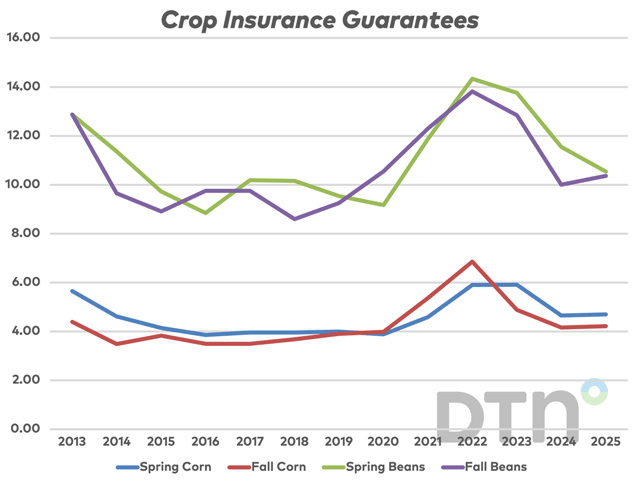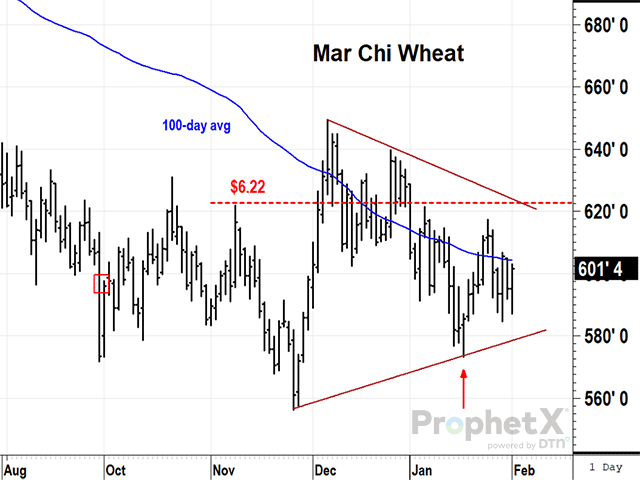Todd's Take
Much Ado About Chicago Wheat Prices
One of the challenges of writing about daily grain prices in winter is there is often not much going on, especially for wheat.
It's no secret the bulk of the world's wheat is grown in the Northern Hemisphere. Here on Feb. 1, southern harvests are wrapping up and winter crops are dormant. Sure, we analysts at DTN note Europe's winter wheat crop will likely be lower in 2024 after planting was limited by excess rain. We are also paying attention to dry conditions in southern Europe and in the Western Canadian Prairies. There may even be a little excitement in the Feb. 8 WASDE report, if anecdotal reports are true that Australia's wheat crop may turn out larger than USDA's estimate of 25.5 million metric tons (mmt) or 937 million bushels (mb).
The most excitement wheat prices typically get in winter is when an export sale shows up. Unfortunately, 2023-24 happens to be a season in which USDA is expecting the lowest export total for wheat in over 50 years, a combination of lower-than-normal U.S. supplies and excess production from Russia after several decades of declining U.S. market share in the world. Eight months into the 2023-24 season, Russia continues to dominate world exports with some of the world's lowest prices, second only to Ukraine.
As of Jan. 25, export commitments for all U.S. wheat totaled 620 mb, up 4% from a year ago and above pace for reaching USDA's 725-mb export estimate, which is 4% less than last year's poor performance. However, shipments need to start picking up as only 396 mb of wheat have moved, down 10% from a year ago at this time.
All wheats are not equal, and the U.S. variety that has the best fundamentals in 2023-24, excluding durum, is soft red winter (SRW) wheat, well known to traders in Chicago. Going by USDA's ending stocks-to-use ratios in January, SRW wheat is estimated at 24.2%, the tightest supply situation in 10 years and less than a 34.6% ratio for HRS wheat and 47.7% for HRW wheat.
P[L1] D[0x0] M[300x250] OOP[F] ADUNIT[] T[]
Hard red spring (HRS) wheat export commitments sport the largest total to date at 202.7 mb in 2023-24, but 164.2 mb of SRW wheat export commitments show the largest percentage gain to date, up 76% from a year ago. The unexpected jump in SRW wheat export sales started Oct. 3, when USDA announced an 8.1 mb sale to China.
There had been talk earlier in the season that China's wheat crop may have suffered from untimely rains at harvest; but given the poor quality of information out of China, it is always difficult to know what to believe. The first indication something was up happened Oct. 2 when March Chicago wheat reversed 22 1/2 cents higher to $5.96, one day after a 33-cent loss.
After a little flurry of prices in October, the market calmed down again and USDA announced a modest SRW wheat sale of 4.0 mb to China on Nov. 22, this time preceded by a 12 1/4-cent gain. Wheat prices responded with a little volatility, but ears were perked and rumors were circulating. March Chicago wheat then traded from a new 2023 low of $5.56 1/4 on the Monday after Thanksgiving to a high of $6.49 1/2 on Wednesday, Dec. 6, followed by 41.2 mb of SRW sale announcements to China that began on Dec. 4 and continued to Dec. 8. The 93-cent rally in seven days was the strongest buying streak the market had seen since July.
After hearing this, you might think Chicago wheat bulls made out pretty well, since that first higher close in October, but that's not the case. On Thursday, Feb. 1, March Chicago wheat closed at $6.01 1/2, up 5 1/2 cents from Oct. 2, the day the first sale to China was about to be announced. USDA's latest export sales report shows 164 mb of total SRW wheat export sales commitments and nearly 79 mb shipped. Since early October, China has shipped 2.2 mb of SRW wheat home and 57.6 mb of purchases remain on the books. Needless to say, there is a little nervousness about China's intentions.
The next largest customer for SRW wheat from the U.S. is Mexico with 30.2 mb of commitments on the books; but two-thirds of their business has been shipped. I have no political hotline to Beijing, but technically speaking, I suspect China will make good on its purchases this time.
March Chicago wheat prices have been chopping slowly lower since making the Dec. 6 high of $6.49 1/2 and have not exceeded the Nov. 27 low of $5.56 1/4. The chart pattern is forming a triangle with a second prominent point of support showing up at $5.73 1/4, the low of a bullish reversal on Jan. 18. The boundaries of the triangle suggest upside potential on a close above $6.22. On the other hand, if prices close below $5.80, all bets are off, the pattern will have failed and we'll have to keep wondering if China will stand by its purchases.
There is not a strong bullish fundamental case for wheat prices, in general, but at these cheap prices, commercials are net long and a wider trading range is in order. I can't make any promises, but of the three U.S. wheat futures, Chicago wheat has the best chance for a modest rally this winter.
**
Comments above are for educational purposes only and are not meant as specific trade recommendations. The buying and selling of grain or grain futures or options involve substantial risk and are not suitable for everyone.
Todd Hultman can be reached at Todd.Hultman@dtn.com .
Follow him on X, formerly Twitter, @ToddHultman1
(c) Copyright 2024 DTN, LLC. All rights reserved.




